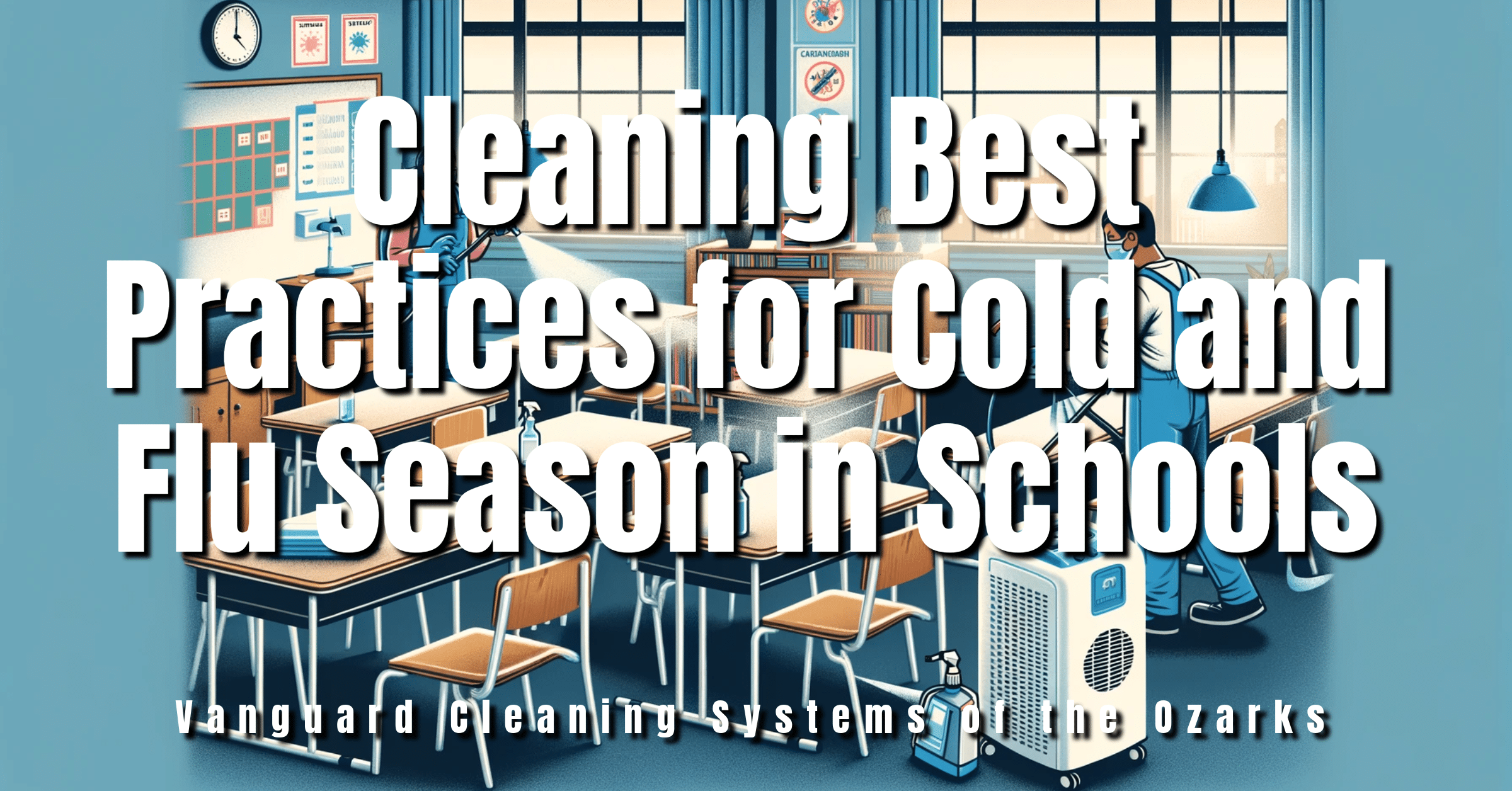Don't let the cold and flu season catch your facility off guard.

Preparing Schools for Cold and Flu Season: A Comprehensive Guide to Cleaning Best Practices
Keeping schools clean and germ-free is especially important during cold and flu season.
By focusing on regular cleaning, giving extra attention to surfaces that people touch a lot, and even thinking about bringing in professional cleaning help, we can help keep kids and teachers from getting sick.
These steps are backed up by expert advice and research, making it a solid game plan for any school.
So, it's not just about cleaning; it's about creating a healthier space for everyone.
The Significance of Routine Cleaning in Schools
In the battle against cold and flu, routine cleaning is a foundational defense strategy.
Activities like dusting, vacuuming, and wiping down frequently touched surfaces can prevent many germs from spreading throughout the school.
The CDC emphasizes that a vigorous cleaning routine is non-negotiable for maintaining a healthy environment in educational settings, particularly during cold and flu season (CDC, 2020).
In simple terms, consistent cleaning is the cornerstone for a healthier school community, cutting down risks right at the source.
Increasing Cleaning Frequency in Peak Illness Times
While a daily cleaning regimen may be sufficient for most of the year, it's advisable to increase the frequency during flu season.
Think of it as added layers of defense during a critical period.
Increasing the number of cleanings to multiple times daily can dramatically reduce the number of active germs present.
This frequency adjustment becomes especially pertinent when the risk of illness is heightened.
The Role of Green Cleaning Products
Another consideration during flu season is the cleaning products being used.
Traditional cleaners may contain harsh chemicals that could aggravate allergies or asthma symptoms, adding another layer of health concerns.
On the other hand, green cleaning products are formulated to be environmentally friendly and generally contain fewer irritating substances.
Some green products are also certified to be effective against the flu virus and other pathogens, offering a safer but still effective alternative (EPA, n.d.).
Choosing the right cleaning products can be just as important as the cleaning process itself in maintaining a healthy school environment.
The Critical Role of Targeted Disinfection of High-Touch Surfaces
One of the most effective strategies in germ control is focusing on frequently touched surfaces, such as doorknobs, handrails, and light switches.
These high-contact points are hotbeds for germs and are more likely to contribute to the spread of viruses like the flu (CDC, 2020).
The Centers for Disease Control and Prevention (CDC) states that disinfecting these surfaces can significantly reduce the risk of transmitting infections.
Targeted disinfection isn't just cleaning for the sake of appearances—it's a calculated move to stop germs right where they spread most.
The Necessity of Using EPA-Approved Disinfectants
Selecting the proper disinfectant is pivotal for effective sanitation.
The Environmental Protection Agency (EPA) has a list of approved disinfectants that are proven to be effective against a wide array of pathogens.
Always read the label for correct application procedures, including how long the disinfectant should remain on the surface to be effective (EPA, n.d.).
Using EPA-approved disinfectants offers assurance that you're engaging in a sanitation process that is both thorough and backed by research.
Following Manufacturer Instructions for Disinfectant Application
It's crucial not just to choose the proper disinfectant but also to apply it correctly.
Misapplication can lead to suboptimal results, leaving room for pathogens to survive.
Always follow manufacturer guidelines for proper dilution ratios, contact time, and compatible surface materials.
Compliance with these guidelines is crucial for ensuring the disinfecting process reaches its full potential.
The Strategic Advantage of Outsourcing Janitorial Services
In times when cleanliness is of the essence, such as during flu season, outsourcing janitorial services becomes more than a convenience—it becomes a strategic advantage.
Professionals in the field are trained to handle the challenges specific to high-risk periods for illness.
They are equipped with the skills, equipment, and specialized cleaning agents, often surpassing what traditional in-house cleaning services can provide (OSHA, n.d.).
Outsourcing janitorial services can elevate the overall well-being and health safety standards of the facility, making it a worthwhile investment for decision-makers.
Top 5 High-Touch Surfaces to Prioritize for Disinfection
When it comes to targeted disinfection, some surfaces are more important to focus on than others.
High-touch areas are breeding grounds for germs and can potentially be primary vehicles for spreading illnesses like the cold and flu.
Prioritizing these surfaces is critical for creating a safer environment (CDC, 2020).
Doorknobs and Handles
Doorknobs and handles are touched countless times each day, making them prime locations for germs.
People touch them not only when entering or leaving a room but also during emergencies and sometimes even absentmindedly.
Their material—often metal—can also provide a hospitable environment for viruses to live for extended periods.
Therefore, these should be disinfected multiple times a day, especially during flu season.
Light Switches
Just like doorknobs, light switches are another high-touch area that might be overlooked. Every time a room's lighting is adjusted, germs can transfer.
Given their flat, often plastic surface, light switches can harbor both bacteria and viruses.
As part of any comprehensive cleaning plan, they should be disinfected at least daily, if not more frequently during peak illness periods.
Handrails
Handrails in stairwells and along hallways are leaned on and gripped by almost everyone in the building.
They are especially crucial to disinfect regularly because of the large volume of hand contact they receive throughout the day.
The vertical orientation also allows for gravity to bring down pathogens, accumulating more germs at the bottom than at the top.
Scheduled disinfecting of handrails can make a significant impact in reducing the spread of viruses.
Classroom Desks and Chairs
Classroom desks and chairs are high-contact pieces of furniture that students interact with for extended periods.
They can collect germs from hands, food, and respiratory droplets.
Any effective cleaning regimen should prioritize the regular disinfection of these items, ideally between different classes or at least once a day.
Shared Electronic Devices
Tablets, keyboards, and other shared electronic devices are frequently handled and can be a hotbed for microbial life.
The complexity of their surfaces—keys, touchscreens, mousepads—makes them challenging to clean but no less critical.
Special care should be taken when disinfecting electronic devices to ensure that the cleaning process does not damage them while still being effective in pathogen removal.
References
- EPA. (n.d.). What information/guidance do you have for managing the flu in school? Retrieved from https://www.epa.gov/iaq-schools/what-informationguidance-do-you-have-managing-flu-school
- OSHA. (n.d.). Seasonal Flu Information for Workers and Employers. Retrieved from https://www.osha.gov/seasonal-flu/non-healthcare-employers
- Centers for Disease Control and Prevention. (2020). Cleaning and Disinfecting Your Facility. CDC. https://www.cdc.gov/flu/school/cleaning.htm
- Environmental Protection Agency. (n.d.). List N: Disinfectants for Use Against SARS-CoV-2. EPA. https://www.epa.gov/iaq-schools/what-informationguidance-do-you-have-managing-flu-school
- Occupational Safety and Health Administration. (n.d.). Seasonal Flu and the Workplace. OSHA. https://www.osha.gov/seasonal-flu/non-healthcare-employers
Takeaway
The need for stringent cleanliness is heightened during the cold and flu season, making it crucial for decision-makers to take proactive steps in maintaining a healthy environment.
While general cleaning practices are necessary, honing in on high-touch surfaces such as doorknobs, light switches, handrails, classroom desks, and shared electronic devices offers a targeted approach that can significantly reduce the spread of pathogens.
It’s not merely a matter of thoroughness; it's a strategic measure that maximizes the impact of your cleaning efforts.
Moreover, the complexities involved in effective cleaning—like the selection and proper application of disinfectants—make a strong case for outsourcing janitorial services.
Professionals in this field bring specialized skills, cutting-edge equipment, and commercial-grade cleaning solutions that often outperform traditional, in-house methods.
If you're serious about maintaining the highest health and safety standards, especially during seasons when illness is more prevalent, consider seeking expert advice or services.
Act now to ensure your facility is prepared for the cold and flu season.
Vanguard Cleaning Systems® of the Ozarks' franchise-owned custodial service provider business cleans more than 8M sq. ft. weekly, maintaining an industry topping 95+% of its customer base, year-over-year, and boasting more than 60 5-star Google reviews.
Need more capability from your vendor partners? --Let's talk.
In Oklahoma, dial 918-960-4450
In Arkansas, dial 479-717-2410
In Missouri, dial 417-812-9777

